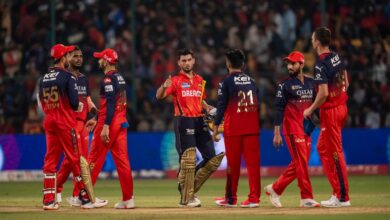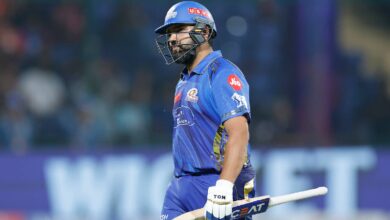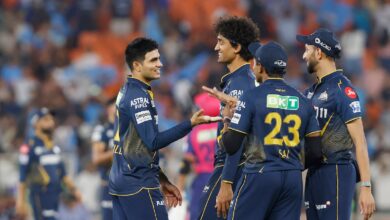Federer + Nadal + Djokovic = Alcaraz

A few weeks back Roger Federer was startled when he heard the lavish praise heaped on Carlos Alcaraz his ex coach, the Croatian Ivan Ljubicic; that Alcaraz has a bit of Federer, Rafael Nadal, and Novak Djokovic. Federer’s response was not to put so much pressure on the kid – “He said that? … It’s a lot to live up to”. On a windy Sunday evening, after losing an epic Wimbledon final, Novak Djokovic, a man who knows a thing or two about change of guards, would bring up that comparison.“I haven’t played a player like him ever, to be honest. I think people have been talking in the past 12 months or so about his game consing of certain elements from Roger, Rafa, and myself. I would agree with that … I didn’t expect him to play so well this year on grass, but he’s proven he’s the best player in the world.”A few minutes later, Alcaraz bounced into the press conference room, after hobnobbing with the royalty, legendary players, and soaking up the moments with the crowd from the famous balcony, and would have a lovely smile when Djokovic’s comment was relayed to him. It wasn’t a smile of surprise as confidence would escape his lips: “He (Djokovic) is probably right!”. Self-appraisals can be a tricky thing but validation from a legend like Djokovic is quite another matter.
Djokovic’s assessment will only add to the ever-evolving hype swirling Alcaraz’s multidimensional game with evidence of all three of the sport’s greatest players – he has shown similarities to Nadal’s lateral movement and fight; Federer’s forehand and audacity; and Djokovic’s backhand and temperament on the big stage.
Tri-brid
Comparisons with Rafael Nadal have followed Alcaraz ever since his emergence as a prodigal teenager. It is easy to see why. The Spanish legacy; the brute power and brawny physicality; the urge to never give up; the thunderous footspeed; the monstrous forehand.
Nadal’s spinning, lasso-like forehand will undoubtedly be a shot forever embedded in tennis iconography, but Alcaraz’s control over the stroke, hitting it flatter through the air with subtler spin, is more reminiscent of Roger Federer.
Tennis – Wimbledon – All England Lawn Tennis and Croquet Club, London, Britain – July 16, 2023 Serbia’s Novak Djokovic with Spain’s Carlos Alcaraz after losing the final REUTERS/Dylan Martinez
So is his commitment to low-percentage, riskier shots that come through in his all-court attacking style. So many of Alcaraz’s strengths are surface-agnostic, making him tough to deal with anywhere. The aggressive court positioning and big forehand shrinking the court for his opponents, and the deft net play and array of low slices keeping them on their toes.
Alcaraz has often spoken of his fondness for Federer in the past, and it shows up in his audacious shot selection. Given Alcaraz’s age, he likely saw Federer during his later years, at a time when he was pulling out all the crafty tricks in his book to get ahead of his baseline-bashing opponents. This included his squash-like open stance forehand slice, rushing the net to return serve which fans dubbed SABR (Sneak Attack Roger), no-looks, and backhand slice disguises.
Alcaraz’s dare has made him just as fresh and compelling to watch. He hasn’t taken any specific shots from Federer’s playbook, but his signature drop shot, disguised to perfection especially on the forehand side, is just as audacious.
It is not just the touch required to pull it off that is startling, but the audacity to unfurl it during the crunch moments – in the crucial second-set tiebreaker, during the hugely significant third game in the third set, while defending break points, while serving for the championship.
For all the similarities, Federer’s dinct weakness – his backhand during marathon crosscourt rallies – have not been co-opted the 20-year-old. His sturdy two-hander is versatile both as a rally shot, and as an option for an easy winner down-the-line, akin to Djokovic.
Mastering the big moments
Sunday’s final showed Alcaraz’s Djokovic-like control and ruthlessness during each of the major moments that swung momentum his way. Like in the second set tiebreaker against the master of tiebreakers after his first-set collapse which he needed to win. At 4-5 in the breaker, Alcaraz would unfurl a perfectly-disguised forehand drop shot, wrong-footing Djokovic. The Serb, from there, would net two simple backhands to drop the set.
The momentum swung, but the match was still in the balance, until the fourth game of the third set. It would last 26 minutes, and 13 deuces, a never-ending blur of booming groundstrokes and loose errors. Alcaraz had brought his forehand into play to command the rallies, but Djokovic showed his trademark resilience, saving six break points. The Spaniard broke the reserves on seventh time of asking, outlasting the marathon man and later racing to a two-sets-to-one lead.
But as Djokovic let Alcaraz ride his momentum, he returned with the fury he usually does, unsurprisingly after one of his famous bathroom breaks. The forehand stopped missing, the first serve and return started firing again, and he took the fourth set in routine fashion.
Serbia’s Novak Djokovic falls as he returns to Spain’s Carlos Alcaraz in the final of the men’s singles on day fourteen of the Wimbledon tennis championships in London, Sunday, July 16, 2023. (AP Photo/Alastair Grant)
It was that final moment that Alcaraz needed to clinch. Djokovic had never lost at Wimbledon after going up one set. The one and only time he had lost a fifth set in a Grand Slam final was 12 years ago, against Andy Murray, also the last player to have defeated him on Centre Court 10 years ago.
In the third game, Alcaraz showed no signs of letting up. Despite an uncharacteric error, Djokovic would do what he does and raise his game. Big first serve, accurate and angled groundstrokes, recovering from a slip like it was nothing, hitting a huge backhand crosscourt to come to the net to finish the point.
And then Alcaraz came up with the moment that won him the match, readjusting off-balance to crunch a huge backhand passing shot down the line. The crowd went into raptures, Djokovic smashed his racquet into pieces on the wooden net pole.
The frustration was understandable, Djokovic had just tasted his own medicine. Time and time again the Serb had devastated opponents stealing wins like this – raising his game just enough to win the key moments. Alcaraz would serve it out for the monumental win, potentially moving the tectonic plates of men’s tennis in the process.
Outpacing the hype
Such had been the stranglehold of the previous generation that on Sunday, Alcaraz became the youngest active player to win either the Australian Open, French Open, or Wimbledon, a record previously held the 36-year-old Djokovic. He became the first multiple Grand Slam champion since Wawrinka in 2015, who was a decade older than Alcaraz at the time.
The achievement is even more significant considering Alcaraz’s two Grand Slam titles mean players born in the 2000s have as many Grand Slams as players born in the 1990s (Daniil Medvedev and Dominic Thiem have each won the US Open once).
It is a testament to the support system around him, and the work of his coaching team led former World No. 1 Juan Carlos Ferrero, that Alcaraz has not only drowned out the considerable noise and hype around his raw talent over the last 18 months, but outpaced it. Even his biggest believers could not have predicted a win for him against Djokovic in a deciding set at Wimbledon just a few years into his professional career. Especially after the nerves-triggered cramps at the French Open final.
The moment of his big win felt significant. But anyone familiar with the different stages of Djokovic’s career will be confident that he has not been dethroned yet. He will be back, a mouthwatering prospect for any tennis fan, given the potential of this era-defining rivalry.







